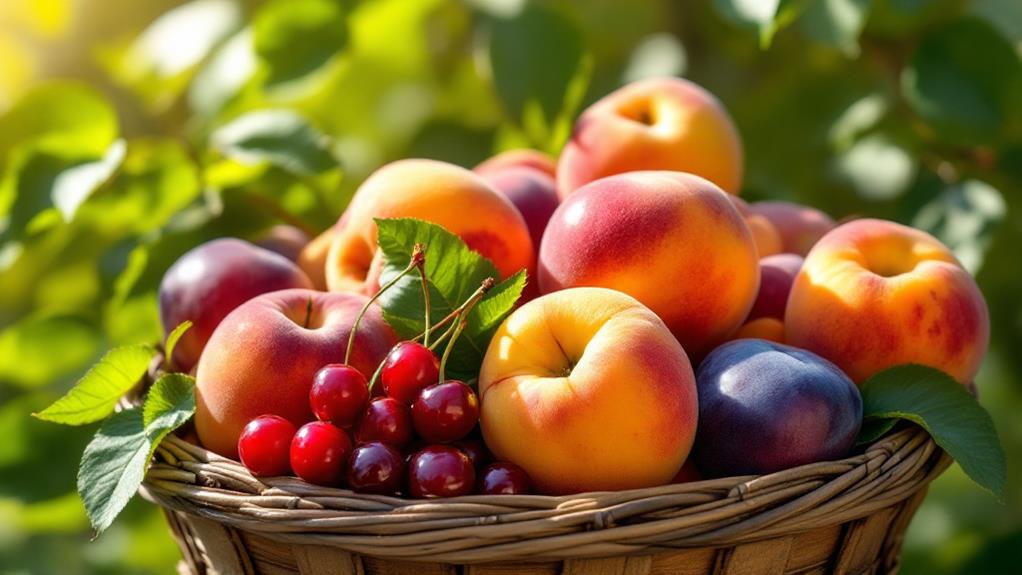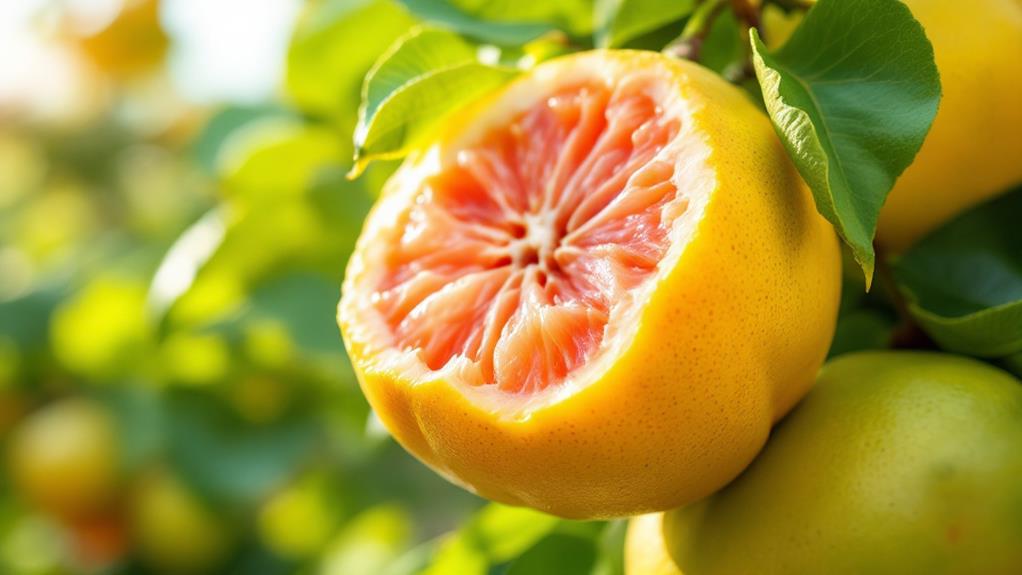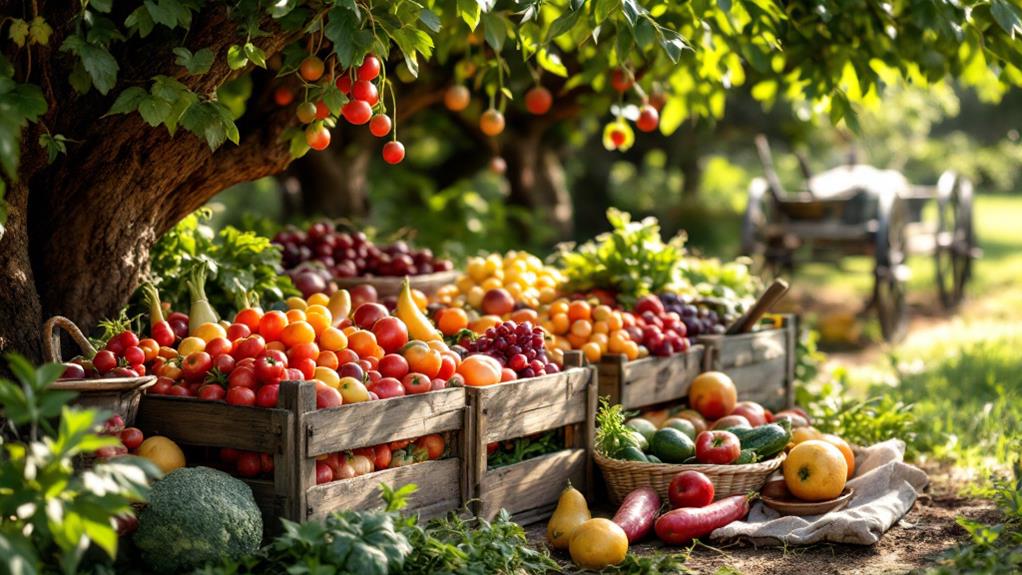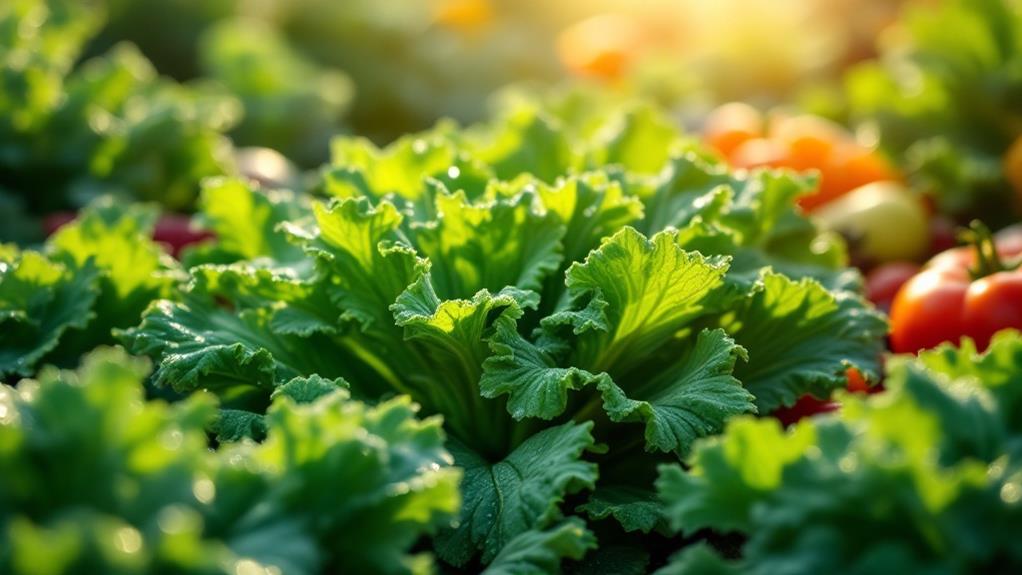What Is Sapodilla? A Guide to This Sweet Tropical Fruit
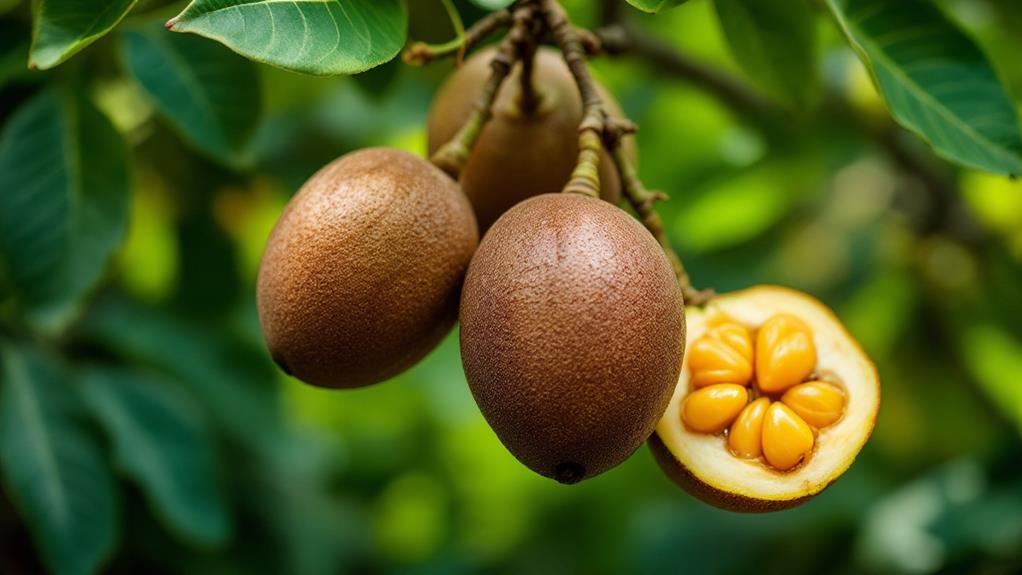
Uncover sapodilla, a sweet tropical fruit that tantalizes your taste buds with its juicy, pear-like flavor mixed with the richness of brown sugar. This unique fruit, about the size of a kiwi, boasts rustic brown skin and juicy translucent flesh filled with shiny seeds. Cultivated in regions like Florida and India, sapodilla thrives in tropical climates and has deep historical roots with the Mayans and Aztecs. It's not just delicious but packed with vitamin C and antioxidants, offering significant health benefits. Investigate further to learn about its culinary versatility and cultural significance.
Botanical Characteristics
The sapodilla, scientifically known as Manilkara zapota, belongs to the Sapotaceae family of tropical evergreen trees. When you contemplate the sapodilla tree, envision a medium-sized, slow-growing tree with glossy, light green leaves. These leaves typically measure between 5-12.5 cm (2-5 inches) in length, providing a lush, lively appearance. The sapodilla tree thrives in tropical and subtropical climates, which means it needs specific conditions to grow and produce its sweet fruit efficiently.
One of the most intriguing aspects of the sapodilla tree is its wood. Known for being reddish, hard, and durable, this wood has historical significance. Ancient Mayans valued it for constructing their magnificent structures, a proof of its strength and resilience. This characteristic makes the sapodilla tree not just a fruit-bearing marvel but also a part of historical architecture.
If you're considering cultivating a sapodilla tree, keep in mind that patience is key due to its slow growth. However, with the right climate and care, your efforts will be rewarded with a beautiful tree and its delicious fruit in due time. Understanding these botanical characteristics will help you appreciate the sapodilla tree's unique qualities.
Fruit Description
When you encounter the sapodilla fruit, you'll notice its unique spheroid to ovoid shape, with a rustic brown skin that ranges from 5 to 10 cm (2 to 4 inches) in diameter. This thin skin isn't meant for consumption, but it protects the delectable gem inside. Once you slice open the sapodilla, you'll reveal its translucent, yellowish-brown flesh. The fruit's juicy pulp offers an extremely sweet flavor profile, often described as a delightful blend between pears and brown sugar.
The texture of the sapodilla's pulp is granular, enhancing its unique taste experience. Inside, you'll typically find 2 to 5 shiny black seeds, resembling flattened beans. These seeds are usually discarded, allowing you to focus on the sweet, rich flesh. When selecting a ripe sapodilla, look for a fruit with dry, wrinkled skin and a soft texture when gently pressed. This softness indicates that the fruit has reached its peak sweetness, promising a satisfying taste.
Cultivation Regions

In the heart of the tropics, sapodilla finds its ideal growing conditions. This sweet fruit, scientifically known as Manilkara zapota, thrives in the warm and humid climates of southern Mexico, Belize, and northeastern Guatemala, where it's native. You'll also find it flourishing in Central America and the Caribbean, regions known for their tropical and subtropical climates that are perfect for sapodilla cultivation.
In the United States, Florida stands out as a prime location for growing sapodilla. The fruit's sensitivity to frost limits its cultivation to frost-free areas, making South Florida an ideal spot. Here, the climate supports the growth of this tropical fruit, allowing it to be harvested and enjoyed from late winter through fall. Hawaii also offers suitable conditions for sapodilla, thanks to its consistent warm weather.
Globally, India and Mexico are major players in sapodilla cultivation. Both countries value the fruit not only for its delicious taste but also for the durable timber from its trees. Wherever you find sapodilla, farmers markets are your best bet to experience the fruit's sweet, unique flavor when it's in season.
Historical Significance
Sapodilla weaves a rich tapestry of historical significance, deeply embedded in the cultures of ancient civilizations. The Aztecs held the sapodilla, or Manilkara zapota, in high regard, chewing its latex as a natural gum. This latex, known as chicle, wasn't just a curious pastime; it became the original source for modern chewing gum. The Mayans, another civilization that valued sapodilla, utilized the tree's sturdy wood for elaborate carvings and structures. This highlights how sapodilla growing played a crucial role in their cultural and artistic expressions.
In addition to its artistic and recreational uses, sapodilla growing also impacted the dietary habits of indigenous peoples in Mexico and Central America. As a staple fruit, sapodilla was integral to their meals, providing fundamental nutrients and sustenance. This fruit didn't just nourish the body; it also contributed to traditional medicine. Known for its medicinal properties, sapodilla was often used in remedies for gastrointestinal disorders, demonstrating its longstanding role in folk medicine.
Understanding the historical significance of sapodilla helps you appreciate its progression from ancient civilizations to your table, where its sweet flavor continues to delight and nourish.
Health Benefits
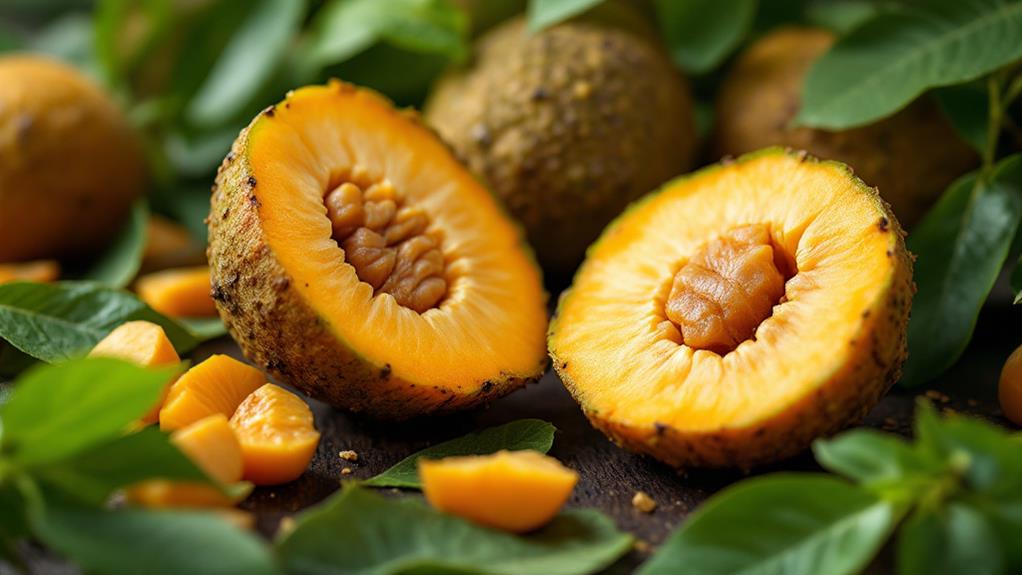
Beyond its historical roots, the sapodilla offers a bounty of health benefits that make it a worthy supplement to your diet. Packed with vitamins and minerals, this sweet tropical fruit is particularly high in vitamin C, which plays a significant role in enhancing your immune function and maintaining skin health. So, if you're looking to ward off colds or keep your skin glowing, sapodilla might be just what you need.
Another great benefit is its high fiber content. The fiber in sapodilla aids digestion, ensuring regular bowel movements and supporting general gut health. If you've ever struggled with digestive issues, incorporating sapodilla into your meals could help keep things moving smoothly.
Sapodilla also contains antioxidants, which are vital in combating oxidative stress. These antioxidants can potentially lower your risk of chronic diseases, making sapodilla a smart supplement to a health-conscious lifestyle. Plus, with its natural sugars, sapodilla provides a quick energy increase without the calorie overload, making it an excellent snack choice.
Historically, sapodilla has been used in traditional remedies for gastrointestinal disorders, suggesting its therapeutic potential. By enjoying this fruit, you're not only treating your taste buds but also nurturing your body.
Culinary Uses
When you engage yourself in the culinary world of sapodilla, you'll find a adaptable fruit that improves both sweet and savory dishes. This tropical fruit's sweet pulp is delightful on its own—just slice it in half and scoop out the flesh with a spoon, much like you would with an avocado. But that's just the beginning of its culinary uses.
In Latin American cuisine, sapodilla shines in batidos, or milkshakes, where its natural sweetness and creamy texture bring a unique flavor. Blending it into smoothies is another great way to add both sweetness and a nutritional uplift. The fruit's flavor is similarly impressive in baked goods; consider adding it to pies or crumbles for an exotic twist.
If you're looking for a snack, dried sapodilla offers a chewy, sweet option. You can also puree the fruit and store it for later use in desserts, offering a quick way to incorporate its taste into diverse recipes. With high fiber content and natural sugars, sapodilla not only provides energy but also supports digestive health, making it a smart choice for a range of dishes.
Harvesting and Ripening
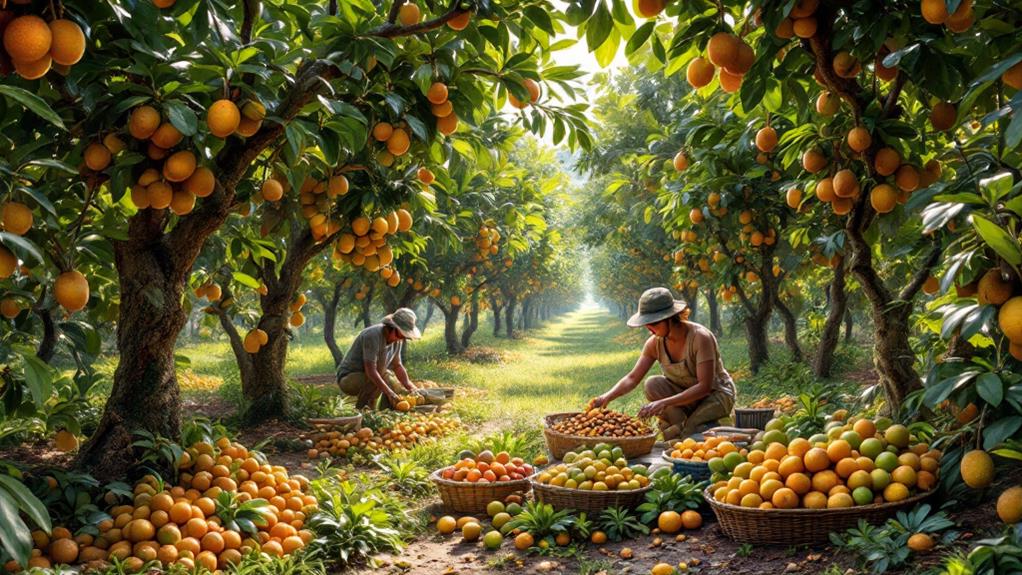
Exploring the culinary versatility of sapodilla opens the door to understanding how to get the best from this tropical fruit, starting with its proper harvesting and ripening. From December through June, sapodilla is at its peak ripeness, making this the ideal time for harvesting. To ascertain the fruit is ready, you can make a small nick in the skin—if you see a tan or tannish-green color, it's time to pick. However, if a green spot appears, the fruit is still immature and should remain on the tree to continue maturing.
Sapodilla trees are generous producers, providing fruit for several months during the season. Once you've harvested sapodilla, it's vital to let it ripen properly. Place the fruit at room temperature, which allows it to ripen naturally over 3 to 10 days. You'll know it's ready to eat when it becomes soft and the skin appears slightly wrinkled. This ripening process is fundamental to developing the sweet, rich flavor sapodilla is known for. By following these steps, you'll enjoy the fruit at its best, maximizing its delightful taste and texture in your culinary creations.
Tree Maintenance
Why is tree maintenance important for a thriving sapodilla tree? Making sure your sapodilla tree receives the right care is key to its health and productivity. Annual pruning is significant. It encourages lateral growth by removing strong vertical branches, helping you keep the tree at an ideal height of fifteen feet or less. This not only makes harvesting easier but also promotes better fruit production. Selective pruning is especially beneficial for cultivars with challenging upright branch structures, improving general tree health.
While pruning, keep in mind that the sapodilla tree's latex can gum up your tools, so clean them thoroughly afterward. Also, be mindful of how you plant your sapodilla tree. The primary flare root should be at or above ground level. Planting too deeply can hinder growth and health. Regular maintenance also involves protecting the tree from mechanical damage. Here's how you can guarantee your tree's long-term health:
- Use guards to prevent damage from string trimmers and mowers.
- Inspect the tree regularly for any signs of disease or pests.
- Keep the area around the trunk free from obstructions and debris.
Buying Tips
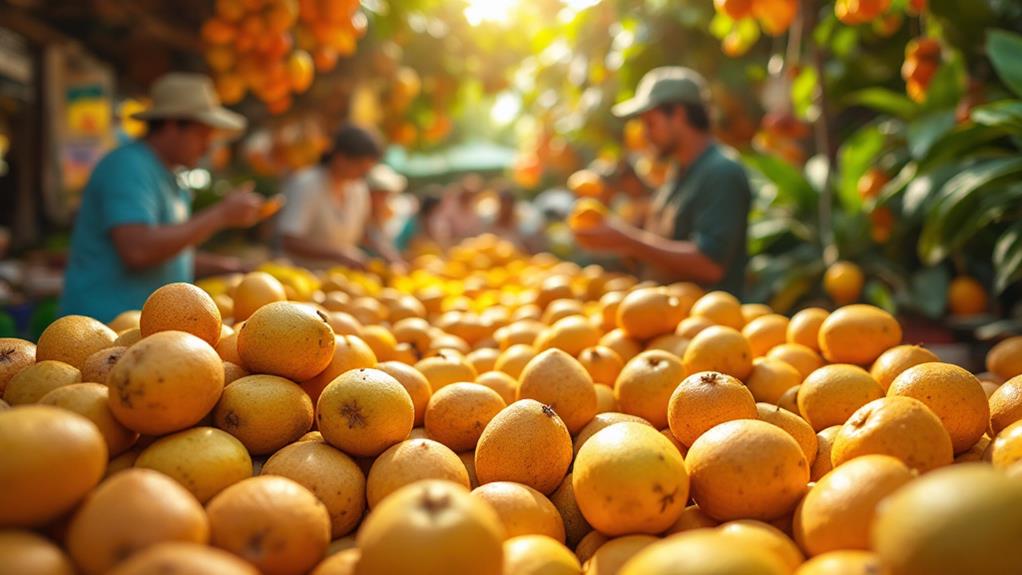
After confirming your sapodilla tree is well-maintained and healthy, you'll want to enjoy its delicious fruits. Regarding buying tips, selecting the right sapodillas is key to enjoying this sweet tropical delight. Look for ripe sapodillas that are soft to the touch and have dry, wrinkled skin. Avoid those with any breaks in the skin to guarantee you're getting the best quality. Since sapodillas are often sold unripe to prevent bruising, expect them to take 3 to 10 days to ripen at room temperature.
For the freshest options, consider purchasing from specialty stores or farmers markets during the peak season, which runs from late winter through fall. If you're buying for your Florida home, you'll find different box sizes available, from sampler to extra-large, and you might even snag a discount on pre-orders. Once ripe, sapodillas can be refrigerated for up to a week to maintain their freshness. However, keep unripe fruits in a cool, dry place to let them ripen naturally. By following these buying tips, you can savor the sweet taste of sapodilla right from your Florida home.
Sustainability Factors
Regarding sustainability factors, sapodilla cultivation shines as an eco-friendly option. These trees thrive with minimal intervention, often relying on natural manure that fits well with sustainable agricultural practices. Thanks to their pest-resistant nature, they don't require heavy chemical pesticide use. This opens up organic cultivation opportunities, especially for small-scale farmers. Concentrated primarily in tropical regions like the Yucatan Peninsula and parts of Central America, sapodilla supports local economies and encourages sustainable farming techniques.
Here's why sapodilla stands out in sustainability:
- Minimal Chemical Use: With pest-resistant trees, you can grow sapodillas organically without harmful pesticides.
- Natural Growth Cycles: The seasonal availability, from late winter through fall, allows for harvesting that aligns naturally, reducing resource strain.
- Support for Local Economies: Buying from small-scale farmers enhances local economies and promotes environmentally friendly practices.
When you engage with local markets and support these small farmers, you contribute to a sustainable supply chain. Sapodilla, with its sweet, brown sugar-like taste, isn't just a delectable fruit; it represents a commitment to eco-friendly and sustainable practices. By choosing sapodilla, you're not only enjoying a delicious treat but also helping to preserve our planet.

